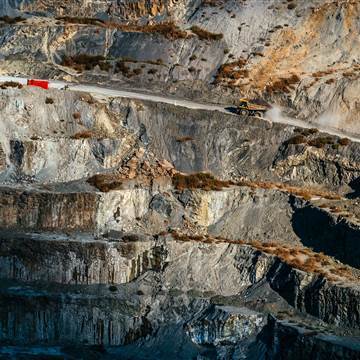Every day, power plants and industries across the globe emit nearly 100 million metric tons of carbon dioxide into the atmosphere — an effect that has pushed our climate into a dangerous zone, causing the Arctic to melt at an alarming rate, sea levels to rise, and weather patterns to shift across the world. But change is brewing and our best shot at reducing those emissions might be right under our feet. Projects are now being developed that capture the harmful gas before it’s released into the atmosphere and bury it deep in the Earth.
The basics of the technology, called carbon capture and storage (CCS) are simple: The toxic gas is pulled out of large emission sources through various chemical techniques. Once the carbon dioxide has been trapped, it’s liquefied, transported through a pipeline and deposited underground — often in natural reservoirs that can hold the gas for millions to billions of years.
Related: Why Scientists Want to Put 10 Million Windmills in the Arctic
To help matters, those geologic reservoirs are abundant. In the United States alone, the Department of Energy estimates that there are enough reservoirs (which include permeable sandstones or deep aquifers) to store nearly 4 trillion metric tons of carbon dioxide. That’s far more than the total amount of carbon dioxide emitted since the industrial revolution.
With such a massive carbon storage facility beneath our feet, scientists have been tackling various CCS projects for decades. The thought was that CCS could ultimately trap up to 90 percent of carbon dioxide emissions — effectively slowing the rate at which we pump out the climate-altering gas.
But 2017 might be a pivotal year for CCS technologies. Experts say that the variety of projects coming online now spotlight the possibilities of the field at large and show its promise for the future. One project might even be able to remove excess carbon dioxide from the atmosphere in a crucial step toward the overarching goal of mitigating climate change.
Carbon Capture Across the Board
Earlier this month, De Beers — the world’s largest diamond producer — announced that it would pilot a project in South Africa designed to create the world’s first carbon-neutral mine. Essentially, De Beers injects carbon dioxide in kimberlite rock, an ore best known for containing diamonds, where the two will combine to form a solid compound. The project is due to start in 2019.
Meanwhile, in Iceland, a geothermal power plant buries 10,000 tons of carbon dioxide per year by injecting it into volcanic rock. In Alberta, Canada, a hydrogen production facility has already captured more than a million tons since it opened 18 months ago. And in Western Australia, a natural gas processing plant captures 3.5 million tons of carbon dioxide per year.


These are just four examples of the many CCS projects launched in recent years. In total, there are 17 large-scale CCS projects across the globe that individually capture more than 1.5 million tons of carbon dioxide each year. And every project, large or small, is crucial to moving forward.
“They’re definitely important bricks in the multi-colored wall that we’re trying to build,” says Stuart Haszeldine, a professor of carbon capture and storage at Edinburgh University. Jeff Erikson, director of the Global CCS Institute, agrees: “They’re very different from each other and I think that reflects the versatility of this technology,” he says.
Related: Can Hacking the Planet Solve Runaway Climate Change?
Other projects aim to utilize the carbon dioxide instead (in a process known as carbon capture and utilization, or CCU). In southern India, a plant is capturing the gas from its coal-powered boiler and converting it into baking soda. In Texas, the new Petra Nova plant will push the compressed carbon dioxide through a pipeline to an oil field 81 miles away. There, the gas will be pumped into wells in a technique known as enhanced oil recovery, which will help increase the amount of crude oil that can be extracted from 300 barrels a day to roughly 15,000 barrels a day.
“You’re starting to see globally, a really interesting portfolio of projects that move us down the field toward commercialization,” says Sallie Greenberg, a researcher with the Illinois State Geological Survey. That’s crucial if we want to meet the commitment created at the 2015 Paris climate conference, namely to limit global warming to two degrees above pre-industrial levels, she says.
Are Negative Emissions Possible?
But there’s one CCS project experts agree stands out from the crowd. Last month, an Archer Daniels Midland (ADM) facility launched the Illinois Industrial Carbon Capture Project, which is expected to store 1.1 million tons of carbon dioxide per year in a sandstone layer a mile-and-a-half underground. Because it builds on a previous project, scientists are certain that billions of tons of carbon dioxide will easily remain trapped within the sediment.
More importantly, the project marries corn-based fuel production and CCS methods — potentially resulting in negative emissions. That’s because the corn naturally pulls carbon dioxide from the atmosphere through photosynthesis as it grows. Then, when that corn is later processed to generate energy, a CCS project will capture even more carbon dioxide. Altogether it will pull more carbon dioxide from the atmosphere than it releases.
“If we’re going to stabilize our climate and stabilize carbon dioxide concentrations in the atmosphere, we have got to get to some carbon negative applications,” Erikson says. “And the ADM project is a good early step toward that goal.”


Negative emissions are crucial because atmospheric concentrations of carbon dioxide will continue hitting record highs until emissions reach zero.
“The Earth is a bit like steering a boat — once it starts moving, it carries on,” Haszeldine says. “We’ve pushed the Earth with lots of carbon dioxide emissions, but we have not yet seen the full effects to the warming or the ocean acidification. So even if you stopped all carbon dioxide emissions tomorrow, then you would still increase by more than two degrees of warming by the end of the century.”
Most computer models that helped form the basis for the Paris agreement’s emission cuts assume negative emission technologies will help countries reach that goal — and do so cost-effectively. (The Intergovernmental Panel on Climate Change recently concluded that without CCS the costs of halting global warming will likely double.) So creating more CCS facilities that actually remove carbon dioxide from the atmosphere, rather than simply slowing the release of the gas, might be the best path forward.
…







